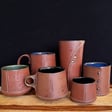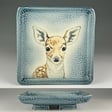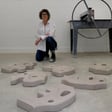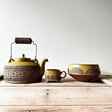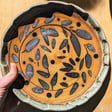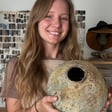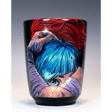Introduction to Jana Dewan & Pottery Exploration
00:00:01
Speaker
What is up, Shaping Nation? This is Nick Torres here, and on today's episode, I gotta interview Jana Dewan. If you don't know, Jana makes some incredible hand-built pottery that she decorates and illustrates all herself.
00:00:14
Speaker
It looks absolutely amazing. In this episode, you will learn why it's so important to learn to make a good pinch pot. You'll also learn the importance of slowing down.
00:00:26
Speaker
And finally, one last thing you you'll learn is allowing yourself to make mistakes. And there's so much more in this episode. Hope you guys enjoy it. Jana absolutely crushed it. And I know you guys will enjoy his episode as well.
Pottery Skills Workshop Announcement
00:00:38
Speaker
But before we get into the episode, if you want to learn how to elevate your own hand-building skills, I did ah a workshop with my good friend Mike Serp, and I'm giving it away for you for free.
00:00:50
Speaker
All you have to do is go to shapingyourproperty.com forward slash goblet to get the replay to the workshop. I'm giving away for free, so don't miss this chance. Now, let's get to the interview.
Importance of Mindfulness in Pottery
00:01:01
Speaker
If you love pottery and want to take your skills to the next level, you're in the right place.
00:01:06
Speaker
Find your own pottery style right here on Shaping Your Pottery with Nick Torres. Let's get started.
00:01:14
Speaker
Dana, welcome Shaping Your Pottery and share with me what is something you believe everyone in the pottery world should be doing.
00:01:22
Speaker
Whenever someone says, this is off topic, sort of, but whenever someone says the word should, i think of someone once told me that there's a reason that the word should belongs in a dictionary between shit and syphilis.
00:01:38
Speaker
And that like the word should is such like a ah dirty word, regardless, not that's not what you're asking me. I believe that every potter should be able to make a good pinch pot.
00:01:51
Speaker
Like it's so simple, deceivingly so. Like making a good pinch pot is something that you're taught in elementary school, but Not really taught how to make a good looking pinch pot, something that is refined and something that you'd be proud to have in your your kitchen or whatever.
00:02:13
Speaker
um But it's something that I used to poo poo so much of like, oh, pinch pots, whatever, like ah some so it's like a ah third grader can make a pinch pot. But it's not. I get to make a really good pinch pot. It's it's really challenging to get something that's refined and looks good.
00:02:30
Speaker
And that takes practice. It also works your way into like being super mindful in your practice. You know, you can make a pinch pot super fast and it looks okay. It's going to hold water, whatever. But if you take your time and slow down and be mindful, be in the moment with your clay as opposed to being distracted by every anything else, there's a big difference between the two.
00:02:56
Speaker
so And that leads into being more in tune with your practice and being in tune with what it the things that you make, the things that you care about, the things that is going to look good and feel good. And so if you have that intentionality with just making a pinch pot, you can bring that into the rest of your pottery techniques.
00:03:21
Speaker
Absolutely love that. Shaping Nation, the more mindful you are about your pottery, even if you're just making a simple pinch pot, the better your pottery will become simply by taking the time and being mindful about it.
00:03:33
Speaker
Absolutely love that.
Jana's Journey into Pottery
00:03:35
Speaker
So tell the story how you got started making pottery. Oh, goodness. That brings me back to high school. So I was definitely like the artsy, fartsy kid in high school. I was also the music nerd.
00:03:49
Speaker
But in high school, my mom's also an artist. My dad dabbles. He's a photographer, sort of. But my mom was the one who really inspired me to pursue art.
00:04:01
Speaker
um I've always been ah drawer and just playing with any art material. So when I got into high school, the main college of art is, was like 30 minutes away from me and they had Saturday classes.
00:04:16
Speaker
um And they had a wheel throwing class. So as a freshman in high school in 2000, that was my first, I think, the one that I remember, the introduction to clay.
00:04:29
Speaker
And I took some classes in in high school, But that was like my first introduction to pottery, I guess. yeah Can you tell me about the moment when you decided to become an art teacher?
00:04:45
Speaker
Oh. So after high school, I took a year off because I wasn't ready to go to college. I traveled and I practiced my musical instruments. I played bassoon.
00:04:58
Speaker
And so I went to Syracuse University for bassoon performance. which I loved. I'm good at bassoon, but it wasn't a passion.
00:05:10
Speaker
And so I found myself, then so then I found a pottery, wheel-throwing class at Syracuse. Errol Willett was my professor. and I found myself using clay studio as my reward for practicing that day.
00:05:27
Speaker
So I would practice for three hours and then in this like cubicle with no windows and no air with my bassoon. And then I was like, yes, I can go to the pottery studio. I can hang out with all these cool people and just make pots for hours and hours.
00:05:44
Speaker
So I graduated with my music degree and I almost went and like pursued something music related. But I found i got I applied and got accepted to work at Watershed Center for Ceramic Arts here in Maine.
The Role of Teaching in Artistic Development
00:05:59
Speaker
And so I worked there for two summers in the kitchen. that's really propelled me rethink my career options. So I didn't know what to do. So I took another year off after college. And it was a conversation with my mother who whoa like asked me to write this list of like, just write down a list of all the things that you thought you think you could do, something that you'd be interested in. and And one of them happened to be an art teacher.
00:06:30
Speaker
ah Actually, before before even wrote that down, i was telling her like, oh, I love working at Watershed. I love having summers off and I love art. And so she was the one who said, oh maybe you just be a teacher. You have summers off. like, great.
00:06:43
Speaker
but but I'll do that. I feel like kind of like a rat sometimes saying like, I got into education because I want summers Yeah. But like that that's kind of the truth.
00:06:56
Speaker
But then I ended up really loving it. So I love my job. I love teaching. I love because I teach mostly ceramics. And I guess ah on the weekends and on at nights on vacations, work on pots as well. So it's a good balance right now.
00:07:10
Speaker
So how has being an art teacher helped you and your pottery? It keeps me excited. You know, because every semester I get to...
00:07:21
Speaker
kind of almost relive this the magic of, oh my God, clay. This is so cool. and get to teach students how to like take a lump of clay and turn it into something that they can actually drink out of.
00:07:37
Speaker
I teach high school, so i i give them a demonstration and then they have open studio time. So in like i check it I check in with them um and chat about what they're doing. And then I i believe it's important to keep up my studio practice so they can see that I'm also a potter.
00:07:58
Speaker
So I always have things going on, that I'm making in the studio. like I'll be working on a piece and I'll go around and show students like, hey, this is what I'm working on. So it's it feels magical that I can b still be an authentic artist and teacher in the classroom. And that I think it's helpful for the students to see that.
00:08:19
Speaker
I absolutely love that.
Finding Authenticity in Style During the Pandemic
00:08:21
Speaker
Now, can you tell me the story, how you started making the pottery that you make today? So I've been making pots for 25 years, but it's only maybe in the past four years that I've been making this style, like maybe three or four.
00:08:38
Speaker
And it's so funny that every couple of years i I'll make this body of work and think, wow, this is my style. And then like a month goes by I'm thinking like, no, and it's like I don't really like that anymore. Like I've kind of gone through that idea and I don't love it anymore.
00:08:57
Speaker
Then, so the pandemic happened. My husband and I bought this house like three weeks before everything shut down. We had this beautiful, gorgeous space. And so like, great, this is the time that to like really get locked in and work on my pots.
00:09:12
Speaker
And since I was still teaching but had... more time to work in the studio, like less commuting time, I commute an hour each way basically. But, and then Naomi Clement was offering an online mentorship program. The first cohort was in 2021. And so I got accepted into that.
00:09:31
Speaker
um And there were, i remember there were eight of us. She accepted eight because eight plus her would be nine that would fit in the screen easily on Zoom. So it was a great group of folks that came together and just wanted to connect about. Or anyway, so that was kind of when I...
00:09:51
Speaker
thought I thought more about what I want my pots to say. Before then, I was making things that were inspired, and on things that just didn't feel authentic to me, things that I thought looked pretty but weren't telling my story. So Naomi Clement gave us a lot of exercises to explore what we noticed and what we was interesting and to bring that into our pots.
00:10:16
Speaker
So it was ah over those was like four or five months that I was part of that mentorship program that that's really where I found my style. I feel confident that this is my style. I've held on to it like for the three or four years, which feels good.
00:10:32
Speaker
Absolutely love that. And we'll talk more about your mentorship with Naomi Clement later.
The Mindful Art of Slowing Down in Pottery
00:10:38
Speaker
But for now, you are inspired by a lot of different things. But the two that stood out for me are recording touch and slowing down.
00:10:47
Speaker
Can you tell me more about this? The recording touch thing is something that I learned from another teacher friend of mine, Seem Vandervan. He's a Maine potter.
00:11:00
Speaker
And I took a workshop with him up at Haystack. And he introduced us all to Paulus Berenson. He was a dancer and potter artist extraordinaire.
00:11:12
Speaker
And he, if you have a chance, go look him up on YouTube. He has this beautiful 10-minute video on... Being in touch with clay and how grounding it is and how you're literally recording your touch every time you squeeze the clay and punch the clay.
00:11:29
Speaker
um and just how powerful that is. It's like you are literally recording your fingerprints onto the clay. And like, how cool is that? go to a museum, like thousands and thousands of year old pottery, you can see that maker's touch, which is just like, it's powerful.
00:11:48
Speaker
So Paulus Berenson. So that that's kind of what I'm thinking about when I make my pots in a way. I'm not trying to make things look perfect. If I wanted a perfect looking pot, I would go to Ikea or some big box store and find something.
00:12:04
Speaker
That looks machine made, but I'm pretty intentional about my pots, my touch on that. Like, so when when, especially when I dip my pots in my slip, like I make sure that have my fingerprint there.
00:12:18
Speaker
And that, I think that just is like so magical. like I keep using that word, but it's just so magical to see like, I made that. Yeah. but Like to have someone else's comments and just see like, oh, that person's fingerprint is right there. Like, that's just so cool.
00:12:36
Speaker
It's a recording touch. Slowing down. Is that the other thing that I said? Yeah. Okay. Yeah, I mean, right now i have the luxury and i I know I'm privileged in saying this, that i have the luxury. I have a full-time job and i don't rely on my pots for my income. It's an extra bonus, but I have the luxury and the privilege to really, really slow down. And that's helping me refine what I want my pots to look like and feel like.
00:13:06
Speaker
um And I view it as sort of like my meditation in a way. It's a way to unwind and somehow to have some like me time. doesn't really talk so much about like the imagery on my pots, I guess, but kind of the mentality of when I go into the pottery studio, it's a way to slow down.
00:13:27
Speaker
Now, how do you think somebody can slow down their own process when they're making? Oh, that's a good question. It's something that I talk about with my students coming back pinch pots. Like I always start a semester off with taking the lump of clay and making it into a pinch pot. And I feel like I'm always amazed at like or taken back by just how fast they want to go.
00:13:54
Speaker
And so there was one time I had i did this, like almost a guided meditation with them, if you want to like stretch and say that. I had them listen to their heartbeats and I said, only pinch with your heartbeat.
00:14:09
Speaker
So that's like in the literal sense of how do you slow down? Just slow, slow down. don't like in a bigger sense. ah give it it's it's I acknowledge that in a unique situation where I'm not on a time c crunch. I don't need to...
00:14:26
Speaker
make things based on someone else's timeline. So I have the luxury of slowing down, but it just, it feels a lot better. I'm out like at the same time, i' i do sometimes rush through things because I'm so excited to see the end result.
00:14:41
Speaker
And then inevitably they come out of the kiln and I'm like, but that's not, why did I just screw that over? I should have slowed down. So it's it's a constant reminder to me too. Like I don't need to rush this drying process at all. I can really let it be.
00:14:58
Speaker
So it's, I tout like slow down, but it's also, it's a message to me. It's reminder to me to also slow down that I don't need to rush the process. yeah I feel you on the rushing part because like i want to like I want to finish. I want to see it come to life. And then it's like, oh, shit.
00:15:15
Speaker
yeah Should have waited another day. yeah Yep, I feel you on that one.
Hand-Building Techniques and Mistakes
00:15:21
Speaker
So you hand build all of your pots. Why do you like hand building?
00:15:27
Speaker
Oh, man, i I only got into hand building in the past like three, four years, I guess with Naomi Clement's mentorship. I was like hell bent on I'm a wheel thrower and I am nothing else.
00:15:41
Speaker
but Like when ah like that, my first classes, the first many, many classes I took in the first like 10 years of schooling, i guess, was all wheel throwing. And I don't know, there's something sexy about wheel throwing and, but it's also messy at the same time or can be messy. Yeah.
00:16:04
Speaker
So in a way, hand building is a way for me to slow down too and be like more intentional with my work. It's also, it feels like I can just like pop into the pottery studio for 30 minutes and get a few things done and leave. It's not like this time, ah time, but like, I don't need to be there for a few hours to make it feel like it counts. Yeah.
00:16:33
Speaker
because if you you know if you sit on the pottery wheel like you're gonna get messy you're gonna like you'll probably have to clean up afterwards ah but it just it feels more accessible the other nice thing about only hand building my pots now is that i have a toddler and so it would be much more challenging to have him come in and like play with some clay and i'm on the pottery wheel and it's not as much of like a bonding experience. In the past couple weeks, he's like every day, he's like, play with clay.
00:17:06
Speaker
So it's been really fun to like hand build with him in the pottery studio. But it also like hand building feels more authentic to me because like it comes back to that recording my touch and I can be And it feels, and mean, it's the same. Like I'm using my hands on the pottery wheel, but using my hands hand building, but it just, it just feels different in my head to, to hand build.
00:17:32
Speaker
Cause I can see my fingerprints when I'm pinching um my coils up. And I just, it's a different feeling. absolutely love that. But what do you think are some of the common mistakes you see when it comes to hand building?
00:17:47
Speaker
For that, I just need to think about what I teach, like my high schoolers. Like, what do they do? We keep talking about, but like, just slowing down. um I'm teaching them how to make slab built cups right now.
00:18:03
Speaker
And something that I say a lot is something that my husband's also a potter and something that he would always say to his students was use soft paws. So like just being really gentle with way the way you handle your clay and having that gentle touch goes a long way with like, especially making a slab cup, like you can't just pick it up with two fingers and like throw it around. You've got to like hold like a like ah like ah an egg or something. So soft pause is something that i I talk a lot about.
00:18:38
Speaker
I guess that's like a technical side of it, like just being careful with your hands and being soft with your hands in a more like existential thing, quintessential way is just, is not just. It's so allowing yourself to make mistakes and letting go of things.
00:19:00
Speaker
and Just experiment and throw it out if you don't like it or recycle it. or But like just making mistakes and failing is so important. Absolutely love that. Shaping Nation, to recap, number one is to just slow down. That's probably the most important thing. Number two is have soft paws.
00:19:18
Speaker
keep Be very gentle with your pots. And then three is to don't be afraid to throw things away if you if you feel like it's not up to your potential. Absolutely love those and those advice.
Decorative Techniques in Pottery
00:19:32
Speaker
So now can you give me a brief explanation on how you add your decorations and designs onto your pots? I posted a reel recently where I asked people, and count the layers. How many layers do i do? There's there's a lot So I hand make all of my stamps and I've got, oh my goodness, I've got so many of them.
00:19:54
Speaker
I make a lot of rollers. This is a roller that that I pushed a flower into. So I'll either push into rolling stamps, I'll carve into rolling stamps.
00:20:05
Speaker
um This one says love for my ah Valentine's Day things. So i'll I'll roll out my slab, I'll add texture to it. I'm working on some nub mugs, zippers right now. And so that's what stage thread. They've got lots of texture.
00:20:22
Speaker
and then the next step is I dip it into a white slip. making sure to keep my fingerprints looking. Once that dries, actually before that, if I if i think of it, sometimes I'll put a ah stencil on the clay, the leather hard clay, and then dip it in to the slip. So then when I peel that off, that's the black of the clay shows through.
00:20:46
Speaker
So sometimes I do stencils and dip and slip. Sometimes it stencils afterwards. I a do underglaze. blocks, like just color blocks. And I do that with strips of newsprints dipped in water.
00:21:01
Speaker
What else do I do? i do monoprints. So I'll, I use my homestead as my inspiration. So i we live on four acres in kind of the middle of woods in Maine.
00:21:14
Speaker
We've got lots of animals and plants and everything. So the things that I put on my pots is the things that are surrounding me. And so I'll draw, I'll either like take a picture of what I see and then turn that into an illustration. I'll draw something and I turn, ah draw that under glaze on a newsprint and I monoprint that onto the little hard clay.
00:21:36
Speaker
What else do I do? Sometimes I scruffy, that's more of an experiment right now. And then I'll fire everything to a bisque fire. I'll do a clear, I'll do a white liner glaze on the inside, but leave the outside unglazed.
00:21:54
Speaker
I haven't quite yet found a clear glaze that looks good that I like over the black clay that I use. So then after the glaze firing, and just sand the shit out of the outside of my pots. Like I'll go from...
00:22:10
Speaker
the all like diamond sanding pads so gut starting from 60 and go all the way up to 800 sometimes so the as outside my pots are still super super smooth don't really love I love the look of it but I'm also I'm experimenting with using clear glaze on the outside because it is a lot of extra work to sand everything so that and all that takes a long time and but I that's that is my process right now and it may change Absolutely love that.
Discovering Artistic Voice and Unique Style
00:22:42
Speaker
So let's talk about discovering your voice. Can you tell me about the moment when you knew you were heading in the right direction with your pottery? Oh, that's definitely with Naomi's mentorship.
00:22:54
Speaker
I swear I'm not getting paid by her to mention her so many times, but she's she's been instrumental and her mentorship was instrumental in finding my voice. And I mean, that's what her mentorship title was called.
00:23:07
Speaker
She gave us a lot of assignments of like, just notice what you notice and keep a log of what do you notice. And so I started noticing colors that I liked. I started noticing things that i was interested in and things that I like I wanted to tell my story. I wanted to tell a story, something that felt authentic and So I started playing around with these monoprints and I did some wood firing of like just monoprints on the clay body, but it felt too bare.
00:23:41
Speaker
I'm looking at ah right in front of me, I have this like shelf, total wall shelf of old pots that I've been making. so I'm looking back like like, oh, that's what I used to do. But I used to just do like simple line drawings on clay and that felt too bland to me. So then how I came up with the idea, but just doing color blocks and that it felt like um the right decision, I guess. So and that's that's when I kind of found what worked for me that I that felt like resonated with my voice of playing with color blocks and playing with illustrations on top of that.
00:24:21
Speaker
What were you feeling when you started doing these color blocks? It felt like I have so much possibility for experimentation.
00:24:33
Speaker
Like I felt, like I mentioned, I've had a lot of iterations of styles that I've done in the past, but it always felt like, well, I've done it and there's not much more that I can experiment with.
00:24:47
Speaker
Like my ideas kind of run its course. This color blocking and monoprints and just imagery from my homestead, it feels like there are endless possibilities of the combinations.
00:25:02
Speaker
And that's what's really exciting is that I found something that Almost like, and I don't want to equate it to like a mathematical equation, but like I have this that I can play with, like the colors I can play with and the um the paper resist I can play with. I can play with stencils. I can play with monoprinting and it all kind of like gels together and it's just, it feels exciting.
00:25:27
Speaker
now you mentioned... In Naomi's mentorship that keeping a log of what you noticed helped you with finding your voice easier. What are some other exercises that you did during that mentorship that really helped you?
00:25:42
Speaker
She had, oh, I just thought of it. in the ah Because I was wheel throwing and i I don't think that I had started handballing that much before mentorship, but one of her assignments that she gave me was to make, play with form.
00:26:02
Speaker
So she had me like, I think she gave me like 10 to 15 different forms of slab because I was thinking very, um what was the phrase I'm thinking of?
00:26:15
Speaker
Like I only had one idea for what a cut could look like. So she told me like make, 10 to 15 different forms. And through that, I still have those. They're in my my classroom at school. I made like 20 different forms from slabs just playing with darting and tapering and adding a different kind of handle and different kind of bottom. So that...
00:26:36
Speaker
that was really really helpful and then from there she had us do lots of other sort of test tiles and and i have those above me and so i then i played with like different textures and she noticed the textures that i was doing but and kind of and because the textures i was doing were just kind of made up textures they didn't mean anything to me and she suggested to make textures, even if they weren't like outright to the viewer what they were, as long as they had meaning to me, that would feel more authentic.
00:27:13
Speaker
So then I started to hone in on like, what are the textures that I want to use? What are the stamps that I want to use? And that propelled me to. So having, making lots of different forms, playing with test tiles, playing with illustrations. It was just a lot, lot of testing and a lot of playing that she had us do.
00:27:30
Speaker
Absolutely love that. Shaping Nation, one of the easiest things you can focus on to help you find your voice is play with form. Form is the easiest thing. It's the one thing that we can all control with our pottery is to just play with form.
00:27:43
Speaker
Absolutely love that.
Exploring Forms and Social Media Inspiration
00:27:45
Speaker
So now what advice would you give to someone looking to discover their own unique voice with their pottery? play, do test tiles.
00:27:54
Speaker
And a test tile doesn't have to be like literal test tiles. um You can make a whole bunch of cups or sippers or whatever, and those could all be your sketchbooks.
00:28:08
Speaker
So being unafraid to just play around is really important. And also, like, yeah I use Instagram a lot. And so on Instagram, I have this folder or a a saved folder that is notice what you notice.
00:28:25
Speaker
And that goes back from the mentorship of so anything that I i come across so like, oh, that kind of catches my eye. i don't need to know why it just pops out like, oh, that looks interesting. I'll put that into that folder. I also have a folder for different forms that I like.
00:28:42
Speaker
And so if I see it a form that catches me, I'll put that in there. And then every once in while, I'll go through and look through those folders. to If I'm feeling stuck in the studio, that's where I'll i'll turn to. Yeah, notice what you notice and and play.
00:28:59
Speaker
Absolutely love that. Jana, it has been a wonderful chatting for you today. And as we come to a close here, what one thing you want to hand home with my listeners today? Play. but but Yeah, just experiment. I always have something ah my sleeve in the studio of like something else that I'm working on, but also filling your bucket with things, maybe not just in the pottery studio, like having other passions that fill your bucket creatively if you're, because there's going to be days, weeks, whatever in the studio where you're just feeling in a rut.
00:29:35
Speaker
And to not let that bog you down so you have another creative outlet that you can turn to. Because it's so like having the burnout and having that like block is going to happen to us.
00:29:46
Speaker
So having other creative outlets is important and and experiment and allowing yourself to experiment. Absolutely love that. Some excellent parting words advice. Jana, it's been wonderful chat today.
Connecting with Jana & Conclusion
00:29:57
Speaker
Where can my listeners go and learn more about you? So on Instagram, it's Jana like banana, Jana with two N's. My husband and I just put together, we have our own business called Turning Art Studio. And so online, we have an Instagram that we just started, but it's really just like me reposting stuff from my Instagram account. But our website is turningartstudio.com. And yeah.
00:30:22
Speaker
It's our pots. And also it's we teach workshops, we teach private lessons and we do body work too. He is a massage therapist. I do Thai massage, Thai body work, but that's where you can find us.
00:30:36
Speaker
Hey, thank you so much for listening to this episode of Shaping your Pottery. I really appreciate it. Don't forget to grab the free goblet workshop with Mike Serv to help elevate your own pottery skills and your own hand building skills. It's completely free. you Just go to shapingyourpottery.com forward slash goblet and you get access to this workshop.
00:30:53
Speaker
I'll see you guys in the next one.

